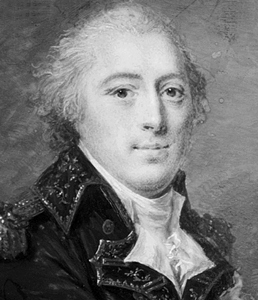General Pierre Thouvenot

Born: March 9, 1757
Place of Birth: Toul, Meurthe-et-Moselle, France
Died: July 21, 1817
Place of Death: Orly, France
Arc de Triomphe: THOUVENOT on the south pillar
Pronunciation:
The son of a master carpenter, Pierre Thouvenot began his career as a geographical engineer in 1774, but then five years later he decided to join the artillery and he began attending the artillery school of La Fère. In 1780 he was commissioned as a sous-lieutenant and he traveled to Guadeloupe where he would remain for a number of years. A promotion to lieutenant followed in 1783 and then in 1788 he was promoted to capitaine. In 1791 Thouvenot was named a Knight of Saint Louis and then in August of 1792 he became director of the foundry at Indret. A few months later in November he was promoted to lieutenant colonel and appointed director of the foundry at Malines. In December he was named commander of the Belgian artillery at Brussels. In February of 1793 Thouvenot became chief of staff to General Dumouriez, and two months later when Dumouriez fled France, Thouvenot fled with him.
Thouvenot ended up at the Duchy of Brunswick in 1794 and remained there for the next five years. After Napoleon Bonaparte as First Consul granted amnesty to the French émigrés who had fled during the French Revolution, Thouvenot took the opportunity to return to France. In October of 1801 he was appointed a chef de brigade and given a position in the army sent to Saint-Domingue. While serving in Saint-Domingue Thouvenot fulfilled a variety of positions including chief of staff and taking command of the artillery. He received a promotion to général de brigade in late 1802. In 1803 Thouvenot began to have doubts about the expedition to Saint-Domingue and in particular about the new commander-in-chief Rochambeau and his policies. He initially limited himself to writing to France about his concerns but eventually he became despondent and convinced he would die in Saint-Domingue. He adopted two illegitimate children, wrote his will, and then began working with General Clauzel to influence Rochambeau. When that proved unsuccessful, Thouvenot and Clauzel began plotting to overthrow Rochambeau and deport him from the island, but in September Rochambeau learned of the plot before it was carried out.1. Thouvenot was confined aboard a ship and then deported to Cuba and afterwards he made his way to France.
Back in France, in September of 1805 General Thouvenot was employed in a division of the Army of the Reserve. In November of 1806 he was named commander of Stettin where he remained until April of 1807 when he joined Grandjean's division. That June Thouvenot was wounded at the siege of Colberg, and he later became governor of Stralsund. 1808 saw Thouvenot going to Spain where he occupied Saint-Sébastien and was placed in command of the province of Guipuzcoa. Rewards followed in 1811 when Thouvenot was named a Baron of the Empire and an Officer of the Legion of Honor.
During July of 1813 Thouvenot was given command of a division in the reserve of the Army of the Pyrenees. That October he was named commander of Bayonne and then the next month he was promoted to général de division. When General Villatte was wounded, Thouvenot took command of a division again and he served under Reille at Saint-Pierre d'Irube on December 12th. A few days later he resumed his command of Bayonne where he was blockaded by the British Army on February 23rd, 1814. Four days later he was wounded by a ball to the thigh, but he continued to defend the city until well after Napoleon's abdication. On the night of April 14th, 1814, he mounted a significant sortie despite having received word that Napoleon had abdicated. The sortie was a success and the French captured the British General Hope who was in command of the siege. However, the sortie was condemned by both sides as a needless waste of life and cost both sides almost a thousand casualties. Thouvenot finally agreed to sign a treaty to raise the siege on May 5th when his French superiors definitively confirmed that the war was over.
When Napoleon returned from Elba for the Hundred Days in 1815, he sent Thouvenot to command at Bayonne again. After Napoleon's second abdication, Thouvenot was put on non-activity and he retired shortly thereafter.
Notes
Bibliography
- Divry, Arnauld. Les Noms Gravés sur l'Arc de Triomphe. Paris: L'Harmattan, 2017.
- Haythornthwaite, Philip J. Who Was Who in the Napoleonic Wars. London: Arms & Armour, 1998.
- Six, Georges. Dictionnaire Biographique des Généraux & Amiraux Français de la Révolution et de l'Empire (1792-1814). 2 vols. Paris: Gaston Saffroy, 2003.
Updated July 2024
© Nathan D. Jensen